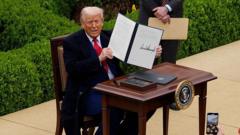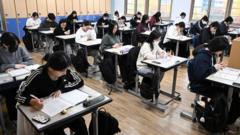Trump's announcement signals a steadfast commitment to aggressive trade measures against key partners.
Trump Unveils 25% Tariffs on South Korea and Japan, Trade Talks at Risk

Trump Unveils 25% Tariffs on South Korea and Japan, Trade Talks at Risk
The US President's new tariffs come as negotiations with multiple countries enter a critical period.
President Donald Trump recently declared his intention to impose a 25% tariff on imports from South Korea and Japan, effective August 1. This announcement, made via social media, included correspondence reportedly sent to leaders of both countries. The White House indicated that similar notices could be dispatched to other nations, as the 90-day window for negotiations regarding more aggressive tariffs nears its end.
Trump’s recent letters reveal a continuation of his earlier trade policy, reaffirming tariff rates first proposed in April. Initially, he aimed to enforce a rate of 24% on Japanese goods and 25% on South Korean products. This tariff push was part of a broader initiative labeled "Liberation Day," targeting a wide array of international imports, with some countries facing tariffs exceeding 40%.
In the wake of widespread criticism and resultant market instability following his initial tariff announcement, Trump opted to postpone implementing some high tariffs to accommodate negotiations while maintaining a 10% levy. The deadline for reaching agreements to avert these increased tariffs approaches on July 9, with Trump confirming that the official tariff imposition will proceed as planned on August 1.
Treasury Secretary Scott Bessent hinted at an active period ahead, stating, “We’ve had a lot of people change their tune in terms of negotiations,” referencing a surge in new proposals from various nations. Initially described by Trump as "reciprocal," these tariffs aim to address what he perceives as unfair trade practices affecting American exports.
Compounding the trade situation, Trump has introduced tariffs on specific sectors such as steel and automobiles, citing national security concerns, while raising the possibility of further tariffs on pharmaceuticals and lumber.
These multilayered tariffs have complicated ongoing trade discussions, particularly with Japan and South Korea regarding automotive tariffs, a crucial obstacle in their negotiations. So far, the US has reached trade agreements with the UK and Vietnam and has partially negotiated with China, although unresolved issues linger for all agreements. Meanwhile, the European Union (EU) is working to maintain a provisional 10% tariff on most goods while negotiating pressure to lower Trump’s heavy tariffs on cars, steel, and aluminum.
Lastly, spokespersons for the EU reported constructive talks between President Ursula von der Leyen and Trump, signifying a willingness to negotiate updates to existing trade arrangements. Recently, Trump warned that Japan could face even steeper tariffs of up to 35% unless an agreement is reached promptly.
Trump’s recent letters reveal a continuation of his earlier trade policy, reaffirming tariff rates first proposed in April. Initially, he aimed to enforce a rate of 24% on Japanese goods and 25% on South Korean products. This tariff push was part of a broader initiative labeled "Liberation Day," targeting a wide array of international imports, with some countries facing tariffs exceeding 40%.
In the wake of widespread criticism and resultant market instability following his initial tariff announcement, Trump opted to postpone implementing some high tariffs to accommodate negotiations while maintaining a 10% levy. The deadline for reaching agreements to avert these increased tariffs approaches on July 9, with Trump confirming that the official tariff imposition will proceed as planned on August 1.
Treasury Secretary Scott Bessent hinted at an active period ahead, stating, “We’ve had a lot of people change their tune in terms of negotiations,” referencing a surge in new proposals from various nations. Initially described by Trump as "reciprocal," these tariffs aim to address what he perceives as unfair trade practices affecting American exports.
Compounding the trade situation, Trump has introduced tariffs on specific sectors such as steel and automobiles, citing national security concerns, while raising the possibility of further tariffs on pharmaceuticals and lumber.
These multilayered tariffs have complicated ongoing trade discussions, particularly with Japan and South Korea regarding automotive tariffs, a crucial obstacle in their negotiations. So far, the US has reached trade agreements with the UK and Vietnam and has partially negotiated with China, although unresolved issues linger for all agreements. Meanwhile, the European Union (EU) is working to maintain a provisional 10% tariff on most goods while negotiating pressure to lower Trump’s heavy tariffs on cars, steel, and aluminum.
Lastly, spokespersons for the EU reported constructive talks between President Ursula von der Leyen and Trump, signifying a willingness to negotiate updates to existing trade arrangements. Recently, Trump warned that Japan could face even steeper tariffs of up to 35% unless an agreement is reached promptly.




















